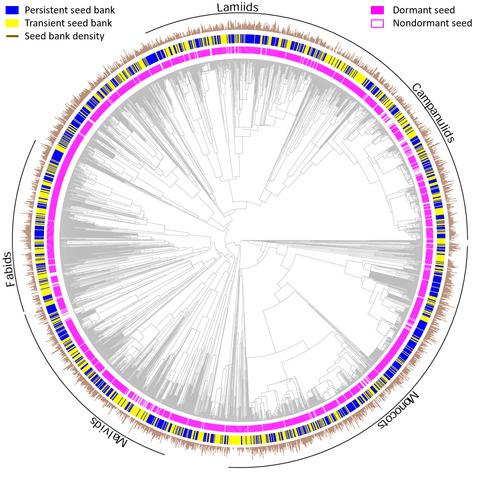Our official English website, www.x-mol.net, welcomes your feedback! (Note: you will need to create a separate account there.)
Phylogenetic relatedness mediates persistence and density of soil seed banks
Journal of Ecology ( IF 5.5 ) Pub Date : 2020-05-25 , DOI: 10.1111/1365-2745.13437 Margherita Gioria 1 , Petr Pyšek 1, 2 , Carol C. Baskin 3, 4 , Angelino Carta 5
中文翻译:

系统发育相关性介导土壤种子库的持久性和密度
更新日期:2020-05-25
Journal of Ecology ( IF 5.5 ) Pub Date : 2020-05-25 , DOI: 10.1111/1365-2745.13437 Margherita Gioria 1 , Petr Pyšek 1, 2 , Carol C. Baskin 3, 4 , Angelino Carta 5
Affiliation

|
- Soil seed banks can strongly affect survival and expansion of plant populations by spreading mortality risks and distributing genetic diversity through time. Knowledge of the main factors regulating the ability of seeds to persist in the soil beyond the first germination season is however limited. While morphological and physiological seed traits, and the degree of environmental uncertainty are considered important in shaping the seed banking strategies of plants, global assessments that explicitly account for phylogenetic relatedness are lacking.
- Using a global seed bank database comprising data for 2,350 angiosperms, we examined the extent to which two seed bank properties, i.e. seed bank type (transient vs. persistent) and density of viable seed banks, are determined by phylogenetic relatedness. We then tested phylogenetic correlations between these properties with seed mass and seed dormancy (dormant vs. non‐dormant), and the contribution of phylogenetic relatedness relative to that of climatic and habitat‐related variables in shaping seed bank properties.
- We found significant phylogenetic signal in seed bank type and density, providing evidence that the ability to form persistent seed banks is not randomly distributed across the phylogeny. While the ability to persist in the soil was phylogenetically correlated to the production of dormant and smaller seeds, seed mass and seed dormancy per se were poor predictors of seed persistence. Interestingly, habitat‐related variables (mainly disturbance and canopy openness) but not climate significantly affect the ability of seed plants to form persistent seed banks.
- Synthesis. Our study is the first to show that phylogenetic relatedness plays an important role in explaining seed bank properties in angiosperms and how these properties relate to early life‐history traits, climate and habitat‐related variables. These findings represent a starting point to assess the generality of persistent seed banks as a bet‐hedging strategy in unpredictable environments and provide important insights into how seed plants might respond to global environmental changes.
中文翻译:

系统发育相关性介导土壤种子库的持久性和密度
- 土壤种子库可通过传播死亡风险和随时间分布遗传多样性而强烈影响植物种群的生存和扩展。但是,对于限制种子在第一个发芽季节之后在土壤中持久存在的能力的主要因素的了解有限。尽管形态和生理种子性状以及环境不确定性的程度在塑造植物种子库策略中被认为很重要,但缺乏明确考虑系统发育相关性的全球评估。
- 使用包含2350个被子植物数据的全球种子库数据库,我们研究了通过系统发育相关性确定两个种子库属性的程度,即种子库类型(瞬时与持久)和可行种子库的密度。然后,我们测试了这些性质与种子质量和种子休眠(休眠与非休眠)之间的系统发育相关性,以及系统发育相关性相对于气候和栖息地相关变量在形成种子库特性中的贡献。
- 我们在种子库的类型和密度中发现了重要的系统发育信号,这提供了形成持久性种子库的能力并非在整个系统发育中随机分布的证据。尽管在土壤中的持久能力与休眠和较小种子的产生在系统发育上相关,但种子质量和种子休眠本身并不是预测种子持久性的良好指标。有趣的是,与生境相关的变量(主要是干扰和树冠开放度),而不是气候,会显着影响种子植物形成持久种子库的能力。
- 综合。我们的研究首次表明,系统发育相关性在解释被子植物的种子库特性以及这些特性与早期生命历史特征,气候和栖息地相关变量之间的关系中起着重要作用。这些发现代表了评估持久性种子库在不可预测的环境中作为对冲策略的普遍性的起点,并提供了关于种子植物如何应对全球环境变化的重要见解。



























 京公网安备 11010802027423号
京公网安备 11010802027423号